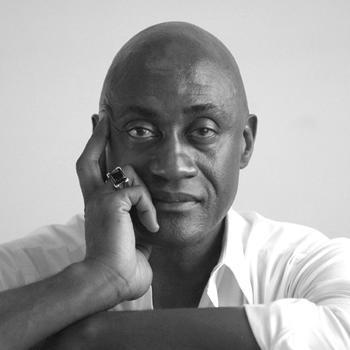Obituary
"The other is not outside; it is in my body"
Ismael Ivo(1955-2021)The Brazilin dancer and choreographer Ismael Ivo was one of the most important artists in dance, performance and theater. Now he has passed at the age of 66 in his hometown of São Paulo. He embodied “interweavings” of different dance and physical cultures like no other dancer. Ivo was a fellow at the IRC “Interweaving Performance Cultures” in 2016/17 and enriched our research discussions with the impressive spectrum of his activities, with the intensity and passion of his dance and with the abundance of ideas in his artistic research. Ivo was born in Brazil, in São Paulo, where he received his training in drama and dance. He performed there as a solo dancer before being invited by Alvin Ailey to New York in 1983. In Germany, he continued creating and performing solo works, which brought him international recognition. He collaborated closely with Johann Kresnik, George Tabori, Yoshi Oida and Ushio Amagatsu of the Sankai Juku ensemble. These varied experiences synthesized with his African-Brazilian roots. In 1984, Ismael Ivo co-founded ImPulsTanz – Vienna International Dance Festival, which has since become Europe’s largest dance festival. The German National Theatre in Weimar appointed him chief choreographer and director of their dance company from 1997 to 2000. From 2005 to 2012 he was director of the International Festival of Contemporary Dance of La Biennale di Venezia. He has also taught at the Max Reinhardt Seminar in Vienna as a visiting professor. Ismael Ivo’s cultural achievement was officially acknowledged when he was awarded the Order of Cultural Merit of the Federative Republic of Brazil in 2010. He returned to Brazil in 2017 as the new Director of the Balé de Cidade de São Paolo. Ivo spent time in Berlin on and off since the 1980s, as a dancer and guest in projects at the Haus der Kulturen der Welt and in other theaters and cultural institutions. Both here and in other spaces in Europe he encountered diverse dance and performance scenes. He was extremely intrigued by different artistic concepts and artists. But he never forgot that he was a Brazilian artist with African roots, and that he was a citizen of the post-colonial society in Brazil, with its fusion of ethnicities. For him it was not a contradiction to act with his Brazilian roots of ritual and shamanism and the heterogenic influences of dance concepts like ballet, modern dance, and Tanztheater. His access to contemporary dance was infiltrated by his awareness that it was important to respond as a Black dancer. He was absorbing such heterogenic influences as the European theater concepts of Antonin Artaud and Jerzy Grotowski, the dialogue with Butoh and Noh from Japan, the dramatic works of Heiner Müller, the photography of Robert Mapplethorpe, the boundary experience in the paintings of Francis Bacon, the expressive and extreme Tanztheater of Johann Kresnik. For Ivo, the body was like a passport of our time, to mirror the multiple social and individual layers of our existence across different cultures. He took up myths and tragic material to interpret them in new and extreme ways as a dancer and choreographer in: “Othello” (1996), "Francis Bacon" (1994) or, as a duo together with the Stuttgart-based prima ballerina Marcia Haydée, also originally from Brazil, “Tristan and Isolde” (1999) or the interpretation of Jean Genet’s “The Maids” (2001) together with Koffi Kôkô, under the direction of Yoshi Oida. What distinguished these artistic works was their obsessive urgency, artistic passion and physical expression which often went to extremes. Ivo’s artistic existence and his cry to his audience was to cross boundaries. He returned again and again to the rituals and myths of his Brazilian roots. The concept of modernism in Brazil, published in 1928 (by Oswald de Andrade) as the “Anthropophagist Manifesto,” was formative for his creative work. Therein lies the idea of cultural, artistic cannibalism, which eats up all foreign influences, digests them and excretes them as a newly transformed work of art. In Ismael Ivo’s own words: "It is not easy to deal with the chaotic mess of the world! It is not easy to accept the human response to it! Eat me up! I vomit in a cascade of movements.” Ivos’s extreme embodiment of the idea of cultural and social entanglements that pass through the body is revealed in this statement. The image that he coined for this is called “biblioteca do corpo.” It is both a dance and a political concept. In his play “Delirium of a Childhood” (1989) he worked with this idea. He interwove his own childhood experiences in the poorest neighborhood in São Paulo, African lullabies, and the expression of mourning in Gustav Mahler’s “Kindertotenlieder.” Long before the Black Lives Matter movement, Ivo dealt with his experiences with the image of the Black body in the Western world and was engaged in the fight against racism and oppression. When he returned to São Paulo in 2017, he saw it as a fresh start to work even harder for equal opportunities, to resist racism, and to start an educational program in dance for children from the poorest of neighborhoods. In the midst of this political and artistic-activist awakening, Ivo lost his life to Covid-19. His legacy in the art of dance and the social world will have lasting effect.
We mourn his loss.
(by Prof. Dr. Gabriele Brandstetter) |

